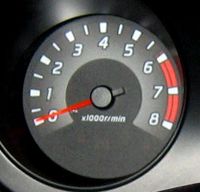.
Tachometer
A tachometer is a device used for measuring the speed of a moving body or substance (from Greek: tachos = speed, metron = measure). The most common form of the tachometer is one that measures the speed of a rotating shaft, as in an engine or other machine. The readout is traditionally in the form of an analog dial, but digital displays are increasingly common.
History
The first, mechanical, tachometers were based on measuring the centrifugal force. The German engineer Dietrich Uhlhorn is assumed to be the inventor, he used it for measuring the speed of machines in 1817. Since 1840 it was used to measure the speed of locomotives.
Automotive
Automotive tachometers show the rate of rotation of the engine's crankshaft by measuring the spark rate of the ignition system, typically in revolutions per minute (RPMs). This can assist the driver in selecting the most appropriate throttle and gear settings (more applicable to manual transmissions than automatics) that the driving conditions call for; or, perhaps more frequently, allow automotive enthusiasts to admire how fast they are "revving" the engine.
Tachometers fitted to cars, aircraft, and other vehicles typically have markings indicating a safe range of speeds at which the engine may be operated. Prolonged use at high speeds may cause excessive wear and other damage to engines. On an analog tachometer this maximum speed is typically indicated by an area of the gauge marked in red, giving rise to the expression of "redlining" an engine - i.e. running it at (dangerously) high speed.

